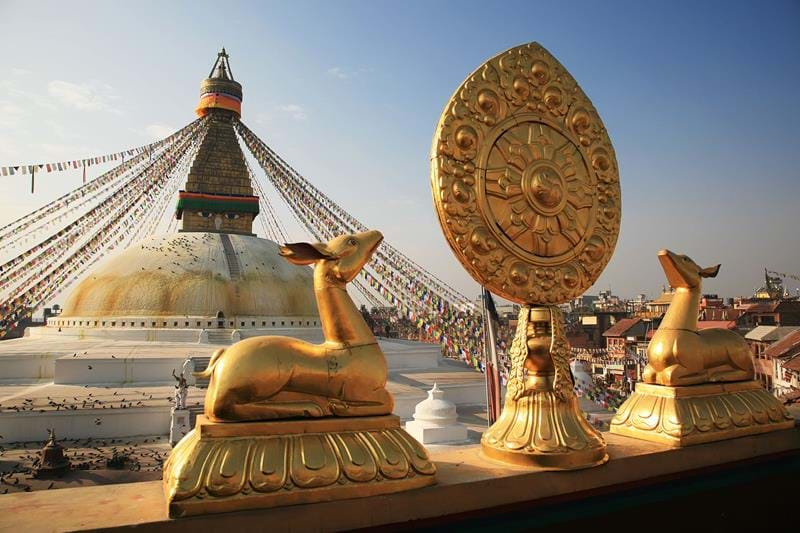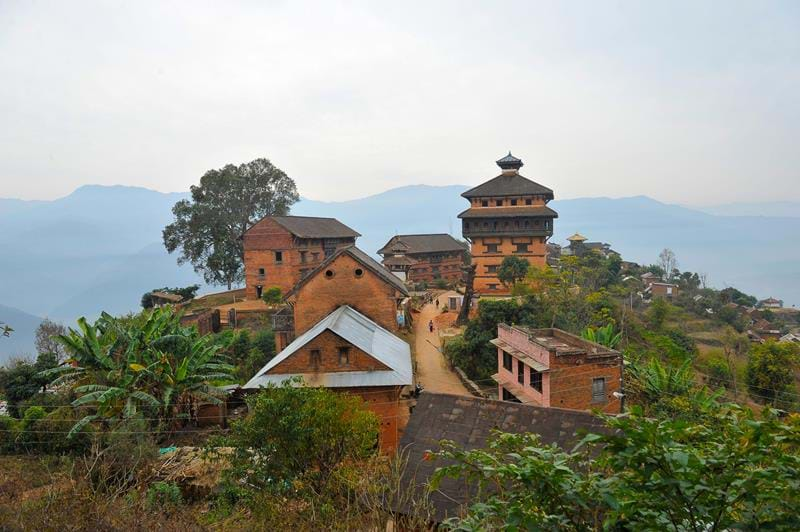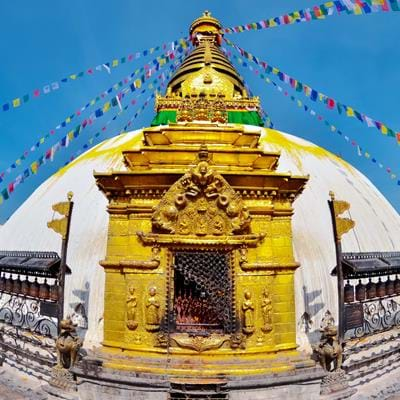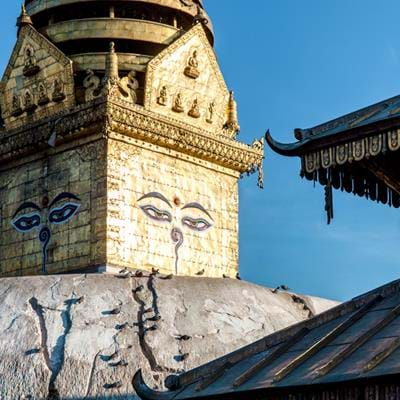Nepal 19.09.2022 Transindus
The Ancient Capitals of Kathmandu, Nepal
The near-mythical cities of Nepal’s Kathmandu valley offer a remarkably well-preserved window into the art, history, and culture of Nepal going back thousands of years. They have stood the test of time and offer a veritable cornucopia of beautiful temples, palaces and monasteries, many of which are UNESCO-listed World Heritage sites.
Legends speak of the Bodhisattva (“Buddha-to-be”) descending from the north and carving out the valley rim to release waters of an enormous Himalayan lake, rendering the lands below habitable, for the propagation of Buddhism. History on the other hand links modern-day Nepal to the Indus Valley civilisation, 3000 years BC. Its indigenous Newar people and their small kingdoms and clans are mentioned in ancient Vedic texts, and archaeological studies confirm it as one of the oldest continuously inhabited places in Asia.
Originally known as Newar Mandala, the region remained largely closed to outsiders and little is known of it other than being a distant outpost of the ancient trade routes. Around 600 BC, the prince of one small kingdom, Kapilvastu, renounced his kingdom and founded Buddhism. Predominately Hindu, the people of Nepal absorbed tenants of Buddhism and established it as a land of spirituality.
In the 4th century BC, the Licchavi kings established the first Buddhist temples in the valley, which remain the most sacred and most popular among pilgrims and visitors even today. Over the centuries the importance of the valley grew, as did its wealth through the lucrative trans-Himalayan trade and successive rulers built ever more elaborate cities. Here is a rundown of Nepal’s most important capitals.

1. Kathmandu
The largest and most prominent of all the Valley's capitals which holds enough fascination to occupy any visitor for days. There is a plethora of things to do here, including visits to the country's first and most compelling Buddhist sites of the Boudhanath and Swayambhunath stupa, and early examples of the distinctive Newar style of architecture with its multiple-tiered pagodas, within elaborate squares. Palaces and monasteries of the city show fine examples of elaborate woodwork punctuated by a series of elaborate temples to the Buddha and various Hindu deities and venerable spirits.
2. Patan
The obvious first foray recommended beyond the city limits is south across the Bagmati River to Patan (aka ‘Lalitpur’ or ‘Manigal’). The Valley’s second largest town holds Nepal’s greatest concentration of historic buildings, the majority of them ranging around the central Durbar Square (one of three Nepali piazzas honoured with World Heritage Site status by UNESCO). Tiled with traditional bricks, the square represents the high watermark of Newari architecture. Numerous grand townhouses and temples sporting handsome pagoda-style eaves open onto it, along with some 136 ‘bahals’ or ‘courtyard monasteries’, as well as the beautiful Palace of the Malla Rajas, whose halls host a museum dedicated to the country’s sacred arts. Restoration work on structures damaged by the 2015 earthquake is ongoing, so some of the monuments have scaffolding around them, but the atmosphere remains undiminished.

4. Madhyapur Thimi
A tiny kingdom situated at the centre of the Kathmandu valley, that nestles aloft high on a hill, overlooking rice fields. The principal site is one of the oldest and played a significant role in the defence of the other cities. Known for their bravery the people of this city are thought of as 'Capable'. Here the principal side is the three-storeyed temple of the goddess Balkumari, the guardian deity of Thimi. In spring she is carried through the street of Madhyapur to the temple of Prachanda Bhairab at the opposite end of town, in an elaborate, unmissable ceremony. Also famous for its pottery and clay works, many of its town squares show beautiful examples of this workmanship including Chapacho, Nasanani, and Tulanani, among others.

3. Bhaktapur
A half-hour drive southeast of Kathmandu, Bhaktapur is focused around another impressive collection of monumental squares, all in high Newari style. It’s a much more easygoing city than the capital, with a historic core that’s blissfully traffic-free and perfect for aimless wanders. Exploring the pretty cobbled streets you’ll come across traditional potters’, weavers’ and wood-carvers workshops, and dozens of picturesque little shrines and local tea shops. During the Bisket Jatra festival in Spring, the city is especially vibrant with street theatre performances throughout the city. A small visitors’ fee is required these days, but the money goes towards restoration work.

5. Nuwakot
Nuwakot, three hours’ drive northwest of Kathmandu on the Trisuli River, was the base from which the redoubtable Gorkha warlord Prithvi Narayan Shah waged his war of attrition against the Malla Dynasty and British East India Company in the mid-18th century. Over 25 years, he succeeded in unifying the Kathmandu Valley, laying the foundation stones of modern Nepal. A reminder of this historic period is the three towers looming above the town’s fort, from which stupendous views of the mountains are revealed. Nuwakot also retains a splendid 18th-century palace and ornately decorated temple. This region has a special fascination for British visitors as the home of the Gurkha soldiers.



6. Panauti
Another top place to visit around Kathmandu is the best preserved Newari town after Bhaktapur and Patan. Panauti lies 45km/28miles east of Kathmandu on a rock outcrop that has for centuries protected it from the effects of earthquakes (including the 2015 quake that wrought such destruction elsewhere). Composed of brick-built houses, shrines and meeting halls made in the traditional pink-brick style the Newars, its core retains a bumper crop of traditional buildings. At the bottom of town, a ribbon of riverside ghats and pilgrims’ hostels is dominated by Nepal’s oldest surviving pagoda, Indreshwar Mahadev, dedicated to Lord Shiva. Centred on a four-faced ‘lingam’, the temple dates from the late 13th century. Nearby, the sacred confluence of the Punyamati and Roshi streams, known as the Khware, is an atmospheric spot for an early morning stroll. Tourists to the city are often offered a warm welcome with colourful stones and petals laid on the pavements a gesture of hospitality.


7. Pharping
Tucked away in the hills on the southern side of the Kathmandu Valley is a village with a disproportionately large number of Tibetan monasteries, most of them swathed in multi-coloured prayer flags in the pine woods above the settlement. Tibetans come here en masse to walk the sacred circuit – or ‘parikrama’ – starting at the large golden statue of Guru Rinpoche, the revered Buddhist missionary saint who is believed to have meditated in a cave here. Colourfully decorated temples, stupas, monasteries and cult images – notably a miracle-working ‘Green Tara’ – punctuate the route, which takes around an hour to complete.


8. Tansen
A crow’s nest town draped along a ridge overlooking the Kali Gandaki river in south-central Nepal Former, Tansen (aka ‘Palpa’) was the capital of the Sen princes. A wonderful collection of antique buildings survives from its 17th-century heyday as a trading hub, forming a labyrinth of narrow, steep streets lined with temples and old-fashioned Newari shop-houses. Many are lined with weaving workshops, where you can watch artisans at work on traditional ‘Dhaka’ treadle looms. Distinguished by its brightly coloured, geometric patterns, the fabric made here is used to fashion the brimless hats beloved by Newari men, as well as traditional ‘Thailo’ purses. The area’s finest Himalayan views are to be had from Srinagar Hill, a half-hour’s walk from the bazaar, from where you can see Dhaulagiri and the Annapurna ranges.
9. Sankhu
The sacred town of Sankhu is located in the northeastern corner of Kathmandu valley, the foundation of which is attributed to the goddess Vajrayoginī (Bajrayyogini), the supreme and powerful deity of the Tantric pantheon. Her shrine sits in the forest above the town, on the flanks of the holy Mount Manichuda. This is one of the few tantric temples to survive and although its main three-tiered tower was destroyed in the 2015 earthquake, the fine gilded doorway flanked by celestial beings and the image of the revered female Ugra-tara, the angered and wrathful female form of Lord Shiva within the temple survive.
Other shrines in the courtyards behind the temple depict a striking fusion of Hindu and Buddhist iconography and a basin nearby houses the “Waters of the Kalpa” which never dry up and the “Fire of the Kalpa” the flame that never fades. The remains of a 2nd-century monastery can also be visited on the way up to the temple.
10. Janakpur
Close to the border with India, the ancient kingdom of Mithila was considered one of the most significant and sophisticated powerful kingdoms of the ancient world. It maintained an independent language, script, culture and art. The goddess Sita from the Hindu epic Ramayana is said to have been born and married to Lord Ram here and the remarkable Janaki Mandir, the main attraction of its capital, Janakpur is dedicated to the goddess.










